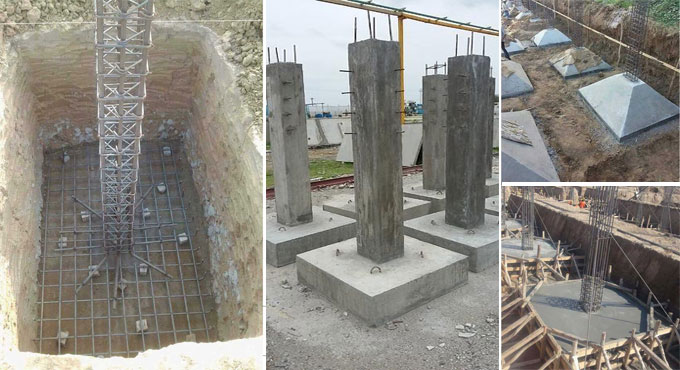
Reinforcement Of Isolated Footing
Isolated footing is mainly used for supporting the individual columns. This type of footing may be either steeped type or have projection in the concrete base. In heavy loaded columns steel reinforcement is provided in both directions in a concrete bed.
There are various types of foundation available in the market. The most popular and simplest type of foundation is the isolation footing. The full load of the building is transferred to the ground through the foundation.
It is the most common footing used for reinforcement cement concrete columns. This type of footing is very affordable for everyone. It is mainly used to support a single column. Isolated footing is independent footing.
Isolated footing is used when:
1. columns are not spaced closely.
2. Loads on footing is not heavy and
3. The safe bearing capacity of the soil is very high.
This type of footing consists of a bottom slab. There are 3 types of bottom slabs are:
Pad Footing: It is that kind of foundation which is intended to sustain the concentrated load from a single point load like a structural column. This is called pad footing. Pad footing has uniform thickness.
Stepped Footing: Stepped footing has non uniform thickness.
Sloped Footing: Sloped footing has a trapezoidal section.
Features of Isolated Footing:
1. The concrete cover of reinforcement
According to the Indian Standard 456-200 the minimum thickness of main reinforcement in footing is minimum 50 mm and the minimum thickness of main reinforcement for the external exposed face is 40 mm. If surface leveling is unused then it is necessary to specify a cover of 75 mm for covering the uneven surface of mining.
2. Minimum reinforcement and bar diameter
Minimum reinforcement is 0.12% of the total cross sectional area. The minimum diameter for main reinforcement is 10 mm.
3. Distribution of reinforcement in footing
The reinforcement is distributed around the whole width of footing. In two way square footings the reinforcement extends in both directions is distributed across the whole width of the footing. In case of short direction the reinforcement is distributed in the central band. The formula is Reinforcement in central band/Total reinforcement in short direction= 2/(x/y)+1 Where y is the long side and x is the short side of the footing.
4. Dowel reinforcement
It is used mainly to tie the isolated footing to the above column. The development length of dowel bars into the column and the isolated footing must be provided.
5. Lap splice
The splice length of dowel and column reinforcement must be shown clearly.
Flexural and dowel reinforcement lengths must be checked to the bond failure of the dowels in the footing and to prevent failure of lap splice of the dowels and column bars.
Advantages
1. This type of footing is affordable for everyone.
2. It is very easy to construct.
3. This footing requires very less earth excavation.
4. unskilled workers can construct this type of footing.
Disadvantage
1. The soil should be stable around the base of the structure.
2. This footing can be very large in size.
In this article we discussed the isolated footing, features, types, advantages and disadvantages of this footing.
If readers like this post please share your valuable feedback with us. Readers can comment in the comments section below the article.


